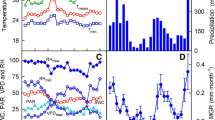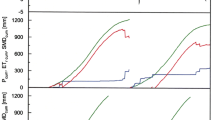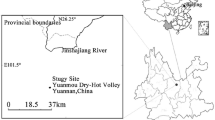Abstract
Key message
Analysis of sap flux density during drought suggests that the large sapwood and rooting volumes of larger trees provide a buffer against drying soil.
Abstract
The southern conifer Agathis australis is amongst the largest and longest-lived trees in the world. We measured sap flux densities (F d) in kauri trees with a DBH range of 20–176 cm to explore differences in responses of trees of different sizes to seasonal conditions and summer drought. F d was consistently higher in larger trees than smaller trees. Peak F d was 20 and 8 g m−2 s−1 for trees of diameters of 176 and 20 cm, respectively, during the wet summer. Multiple regression analysis revealed photosynthetically active radiation (PAR) and vapour pressure deficit (D) were the main drivers of F d. During drought, larger trees were more responsive to D whilst smaller trees were more responsive to soil drying. Our largest tree had a sapwood area of 3,600 cm2. Preliminary analysis suggests stem water storage provides a buffer against drying soil in larger trees. Furthermore, F d of smaller trees had higher R 2 values for soil moisture at 30 and 60 cm depth than soil moisture at 10 cm depth (R 2 = 0.68–0.97 and 0.55–0.67, respectively) suggesting that deeper soil moisture is more important for these trees. Larger trees did not show a relationship between F d and soil moisture, suggesting they were accessing soil water deeper than 60 cm. These results suggest that larger trees may be better prepared for increasing frequency and intensity of summer droughts due to deeper roots and/or larger stem water storage capacity.








Similar content being viewed by others
References
Ahmed M, Ogden J (1987) Population dynamics of the emergent conifer Agathis australis (D. Don) Lindl. (kauri) in New Zealand. 1. Population structures and tree growth rates in mature stands. NZ J Bot 25:217–229
Allan HH (1961) Flora of New Zealand. Owen, Govt Printer, Wellington
Bieleski RL (1959) Factors affecting growth and distribution of kauri (Agathis australis Salisb.). Aust J Bot 7:252–294
Bucci S, Scholz F, Goldstein G, Hoffmann W, Meinzer F, Franco A, Giambelluca T, Miralles-Wilhelm F (2008) Controls on stand transpiration and soil water utilisation along a tree density gradient in a neotropical savanna. Agric For Meteorol 148:839–849
Burns B, Smale M (1990) Changes in structure and composition over fifteen years in a secondary kauri (Agathis australis)-tanekaha (Phyllocladus trichomanoides) forest stand, Coromandel Peninsula New Zealand. New Zeal J Bot 28:141–158
Choat B, Jansen S, Brodribb T, Cochard H, Delzon S, Bhaskar R, Bucci S, Field T, Gleason S, Hacke U, Jacobsen A, Lens F, Maherali H, Martinez-Vilalta J, Mayr S, Mencuccini M, Mitchell P, Nardini A, Pittermann J, Pratt R, Sperry J, Westoby M, Wright I, Zanne A (2012) Global convergence in the vulnerability of forests to drought. Nature 491:752–755
Ecroyd CE (1982) Biological flora of New Zealand. 8. Agathis australis (D. Don) Lindl. (Araucariaceae) kauri. New Zeal J Bot 20:17–36
Ford CR, Goranson CE, Mitchell RJ, Will RE, Teskey RO (2004) Diurnal and seasonal variability in the radial distribution of sap flow: predicting total stem flow in Pinus taeda trees. Tree Physiol 24:941–950
Ford C, Hubbard R, Vose J (2011) Quantifying structural and physiological controls on variation in canopy transpiration among planted pine and hardwood species in the southern Appalachians. Ecohydrology 4:183–195
Fowler A (2008) ENSO history recorded in Agathis australis (kauri) tree rings. Part B: 423 years of ENSO robustness. Internat J Climatol 28:21–35
Fowler A, Boswijk G, Gergis J, Lorrey A (2008) ENSO history recorded in Agathis australis (kauri) tree rings. Part A: kauri’s potential as an ENSO proxy. Internat J Climatol 28:1–20
Goldstein G, Andrade J, Meinzer F, Holbrook N, Cavalier J, Jackson P, Celis A (1998) Stem water storage and diurnal patterns of water use in tropical forest canopy trees. Plant, Cell Environ 21:397–406
Granier A (1985) Une nouvelle methode pour la mesure du flux deseve brute dans le tronc des arbres. Ann Sci For 42:193–200
Holbrook M (1995) Stem water storage. In: Gartner B (ed) Plant stems: physiology and functional morphology. Academic, San Diego, pp 151–174
IPCC (2013) Climate Change 2013: The Physical Science Basis. Working Group I Fifth Assessment Report of the Intergovernmental Panel on Climate Change. Stockholm, Sweden
James S, Clearwater MJ, Meinzer FC, Goldstein G (2002) Heat dissipation sensors of variable length for the measurement of sap flow in trees of deep sapwood. Tree Physiol 22:277–283
Jarvis PG (1976) The interpretation of the variations in leaf water potential and stomatal conductance found in canopies in the field. Phil Trans R Soc Lond B 273:593–610
Katul G, Todd P, Pataki D, Kabala Z, Oren R (1997) Soil water depletion by oak trees and the influence of root water on the moisture content spatial statistics. Water Resourc Resear 33:611–623
Kelliher F, Köstner B, Hollinger D, Byers J, Hunt J, McSeveny T, Meserth R, Weir P, Schulze E (1992) Evaporation, xylem sap flow and tree transpiration in a New Zealand broad leaf forest. Ag For Met 62:53–73
Macinnis-Ng C, Schwendenmann L (2015) Litterfall, carbon and nitrogen cycling in a southern hemisphere conifer forest dominated by kauri (Agathis australis) during drought. Plant Ecol 216:247–262
Macinnis-Ng C, Schwendenmann L, Clearwater M (2013) Radial varation of sap flow of kauri (Agathis australis) during wet and dry summers. Acta Hort 991:205–214
Martínez-Vilalta J, Mangirón M, Ogaya R, Sauret M, Serrano L, Peñuelas J, Piñol J (2003) Sap flow of three co-occurring Mediterranean woody species under varying atmospheric and soil water conditions. Tree Physiol 23:747–758
McDowell N, Pockman W, Allen C, Breshears D, Cobb N, Kolb T, Plaut J, Sperry J, West A, Williams D, Yepez E (2008) Mechanisms of plant survival and mortality during drought: why do some plants survive while others succumb to drought? New Phytol 178:719–739
McGlone M, Richardson S, Jordan G (2010) Comparative biogeography of New Zealand trees: species richness, height, leaf traits and range sizes. New Zeal J Ecol 34:137–151
Meason DF, Mason WL (2013) Evaluating the deployment of alternative species in planted conifer forests as a means of adaptation to climate change—case studies in New Zealand and Scotland. Annals For Sci. doi:10.1007/s13595-013-0300-1
Meinzer FC, Golstein G, Andrade JL (2001) Regulation of water flux through forest canopy trees: do universal rules apply? Tree Physiol 21:19–26
Meinzer F, James S, Goldstein G (2004) Dynamics of transpiration, sap flow and use of stored water in tropical forest trees. Tree Physiol 24:901–909
Meinzer F, Woodruff D, Eissenstat D, Lin H, Adams T, McCulloh (2013) Above- and belowground controls on water use by trees of different wood types in an eastern US deciduous forest. Tree Physiol 33:345–356
Mullan B, Porteous A, Wratt D, Hollis M (2005) Changes in drought risk with climate change. National Institute for Water and Atmospheric Research Ltd., Wellington 68
NIWA (2013) In brief: dry run. https://www.niwa.co.nz/publications/wa/water-atmosphere-7-june-2013/in-brief-dry-run. Published June 2013, accessed 5th March 2014
O’Grady A, Eamus D, Cook PG (2006) Comparative water use by the riparian trees Melaleuca argentea and Corymbia bella in the wet-dry tropics of northern Australia. Tree Physiol 26:219–228
Ogden J, Wilson A, Hendy C, Newnham R (1992) The late Quaternary history of kauri (Agathis australis) in NZ. J Biogeog 19:611–622
Oren R, Pataki D (2001) Transpiration in response to variation in microclimate and soil moisture in southeastern deciduous forests. Oecologia 127:549–559
Oren R, Phillips N, Ewers B, Pataki D, Megonigal J (1999) Sap-flux-scaled transpiration responses to light, vapour pressure deficit, and leaf are reduction in a flooded Taxodium distichum forest. Tree Physiol 19:337–347
Pfautsch S, Adams M (2013) Water flux of Eucalyptus regnans: defying summer drought and a record heatwave in 2009. Oecologia 172:317–326
Phillips N, Oren R (1998) A comparison of representations of canopy conductance based on two conditional time-averaging methods and the dependence of daily conductance on environmental factors. Ann Sci For 55:217–235
Phillips N, Bond B, McDowell N, Ryan M (2002) Canopy and hydraulic conductance in young, mature and old Douglas-fir trees. Tree Physiol 22:205–211
Pineda-García F, Horacio P, Meinzer F (2013) Drought resistance in early and late secondary successional species from a tropical dry forest: the interplay between xylem resistance to embolism, sapwood water storage and leaf shedding. Plant, Cell Environ 36:405–418
Pittermann J, Sperry J, Hacke U, Wheeler J, Sikkema E (2006) Inter-tracheid pitting and the hydraulic efficiency of conifer wood: the role of tracheid allometry and cavitation protection. Am J Bot 93:1265–1273
Quinn GP, Keough MJ (2002) Experimental design and data analysis for biologists. Cambridge University Press, New York
R Development Core Team (ed) (2011) R: a language and environment for statistical computing. R Foundation for Statistical Computing, Vienna
Saveyn A, Steppe K, Lemeur R (2008) Spatial variability of xylem sap flow in mature beech (Fagus sylvatica) and its diurnal dynamics in relation to microclimate. Botany 86:1440–1448
Scholz F, Phillips N, Bucci S, Meinzer F, Golstein G (2011) Hydraulic capacitance: biophysics and functional significance of internal water sources in relation to tree size. In: Meinzer (ed) Size- and age-related changes in tree structure and function. Springer, Dordrecht, pp 341–361
Schulz ED, Čermák J, Matyssek R, Penka M, Zimmermann R, Vasícek F, Gries W, Kučera J (1985) Canopy transpiration and water fluxes in the xylem of the trunk of Larix and Picea trees—a comparason of xylem flow, porometer and cuvette measurements. Oecologia 66:475–483
Silvester WB (2000) The biology of kauri (Agathis australis) in New Zealand II. Nitrogen cycling in four kauri forest remnants. New Zeal J Bot 38:205–220
Silvester WB, Orchard TA (1999) The biology of kauri (Agathis australis) in New Zealand. I. Production, biomass, carbon storage, and litter fall in four forest remnants. New Zeal J Bot 37:553–571
Sterck F, Bongers F (2001) Crown development in tropical rainforest trees: patterns with tree height and light availability. J Ecol 89:1–13
Stephens DW, Silvester WB, Burns BR (1999) Differences in water-use efficiency between Agathis australis and Dacrydioides are genetically, not environmentally determined. New Zeal J Bot 37:361–367
Steward G, Beveridge A (2010) A review of NZ kauri (Agathis australis (D.Don) Lindl.): its ecology, history, growth & potential for management for timber. New Zeal J For Sci 40:33–59
Stöhr A, Lösch R (2004) Xylem sap flow and drought stress of Fraxinus excelsior saplings. Tree Physiol 24:169–180
Thomas G, Ogden J (1983) The scientific reserves of Auckland University I. General introduction to their history, vegetation, climate and soils. Tane 29:143–161
Vergeynst LL, Dierick M, Bogaerts J, Cnudde V, Steppe K (2015) Cavitation: a blessing in disguise? New method to establish vulnerability curves and assess hydraulic capacitance of woody tissue. Tree Physiology. http://treephys.oxfordjournals.org/content/early/2014/07/15/treephys.tpu056.full.pdf+html (in press)
Verkaik E, Jongkind AG, Berendse F (2006) Short-term and long-term effects of tannins on nitrogen mineralisation and litter decomposition in kauri (Agathis australis (D. Don) Lindl.) forests. Plant Soil 287:337–345
Verkaik E, Gardner R, Braakhekke W (2007) Site conditions affect seedling distribution below & outside the crown of kauri trees (Agathis australis). New Zeal J Ecol 31:13–21
Wardle P (2002) Vegetation of New Zealand. The Blackburn Press, Caldwell New Jersey
Whitley R, Zeppel M, Armstrong N, Macinnis-Ng C, Yunusa I, Eamus D (2008) A modified Jarvis-Stewart model for predicting stand-scale transpiration of an Australian native forest. Plant Soil 305:35–47
Whitley R, Macinnis-Ng C, Zeppel M, Williams M, Hutley L, Berringer J, Eamus D (2011) Modelling productivity and water use across five years in a mixed C3 and C4 savanna using a soil-plant-atmosphere model: GPP is light limited, not water limited. Glob Change Biol 17:3130–3149
Whitley R, Taylor D, Macinnis-Ng C, Zeppel M, Yunusa I, O’Grady A, Froend R, Medlyn B, Eamus D (2013) Developing an empirical model of canopy water flux describing the common response of transpiration to solar radiation and VPD across five contrasting woodlands and forests. Hydrol Process 27:1133–1146
Wullschleger S, Wilson K, Hanson P (2000) Environmental control of whole-plant transpiration, canopy conductance and estimates of the decoupling coefficient for large red maple trees. Ag For Met 104:157–168
Wunder J, Perry G, McCloskey S (2010) Structure and composition of a mature kauri (Agathis australis) stand at Huapai Scientific Reserve, Waitakere Range New Zealand. Tree-Ring site report No. 33. University of Auckland School of Environment Working Paper No. 39
Wunder J, Fowler A, Cook E, Pirie M, McCloskey S (2013) On the influence of tree size on the climate-growth relationship of New Zealand kauri (Agathis australis): insights from annual, monthly and daily growth patterns. Trees. doi:10.1007/s00468-013-0846-4
Wyse SV, Burns BR (2013) Effects of Agathis australis (New Zealand kauri) leaf litter on germination and seedling growth differs among plant species. New Zeal J Ecol 37:178–183
Wyse SV, Burns BR, Wright SD (2013a) Distinctive vegetation communities are associated with the long-lived conifer Agathis australis (New Zealand kauri, Araucariaceae) in New Zealand rainforests. Austral Ecol 39:388–400. doi:10.1111/aec.12089
Wyse SV, Macinnis-Ng CMO, Burns BR, Clearwater MJ, Schwendenmann L (2013b) Species assemblage patterns around a dominant emergent tree are associated with drought resistance. Tree Physiol 33:1269–1283
Zeppel MJB (2013) Convergence of tree water use and hydraulic architecture in water-limited regions: a review and synthesis. Ecohydrol 6:889–900
Zeppel MJB, Eamus D (2008) Coordination of leaf area, sapwood area and canopy conductance leads to species convergence of tree water use. Aust J Bot 56:97–108
Zeppel MJB, Macinnis-Ng CMO, Yunusa IAM, Armstrong N, Whitley R, Eamus D (2008) Long term trends of stand transpiration in a remnant forest during wet and dry years. J Hydrol 349:200–213
Author contribution statement
CM, MC and LS designed the experiments. MC designed and constructed the sap flow sensors. CM and SW did the statistical analysis and produced the figures with AV. All authors contributed to fieldwork and manuscript preparation.
Acknowledgments
We thank the following students and interns for assistance in the field: Chris Goodwin, Malani Sundaram, Andrew Wheeler, Tristan Webb, Roland Lafaele-Pereira. We acknowledge technical support from Colin Monk, David Wackrow, Brendan Hall, David Jenkinson and Colin Yong. Thanks Ian and Angela Knightbridge for hosting our weather station on their land and Freddie Hjelm and his team of climbers for climbing the trees. This project was supported by a grant from the Royal Society of New Zealand’s Marsden Fund (UOA1207) to CM and a Faculty Research Development Fund Grant from the University of Auckland to LS and CM.
Conflict of interest
The authors declare that they have no conflict of interest.
Author information
Authors and Affiliations
Corresponding author
Additional information
Communicated by A. Braeuning.
Rights and permissions
About this article
Cite this article
Macinnis-Ng, C., Wyse, S., Veale, A. et al. Sap flow of the southern conifer, Agathis australis during wet and dry summers. Trees 30, 19–33 (2016). https://doi.org/10.1007/s00468-015-1164-9
Received:
Revised:
Accepted:
Published:
Issue Date:
DOI: https://doi.org/10.1007/s00468-015-1164-9




